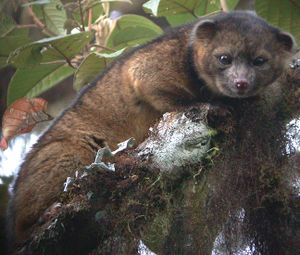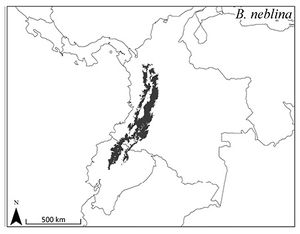أولینگیتو
| اولینگیتو Olinguito | |
|---|---|

| |
| التصنيف العلمي | |
| مملكة: | |
| Phylum: | |
| Class: | |
| Order: | |
| Family: | |
| Genus: | |
| Species: | B. neblina
|
| Binomial name | |
| Bassaricyon neblina هلگن، 2013
| |

| |
أولینگیتو (olinguito ؛ النطق الإنگليزي: /ˌoʊlɪŋˈɡiːtoʊ/؛ oh-lihn-GEE-toe[1]؛ الاسم العلمي: Bassaricyon neblina)، اللقب الإسپاني الذي يطلق على "الأولينگو الصغير"، هو حيوان ثديي من جنس باساريكون في فصيلة الراكونيات (فصيلة الراكون) يعيش في الغابات الجبلية في كولومبيا والإكوادور. أُعلن عن اكتشافه في 15 أغسطس 2013.[2][3]
الوصف
يختلف الاولینگیتو عن أنواع الأولینگو الأخرى الموجودة في نفس الجنس، وكذلك عن الكينكاجو (حيوانات تشبه الاولينگو، لكنها غير وثيقة الصلة به).[4][5] يصل متوسط وزن الاولينگيتو إلى 900 گرام، مما يجعله أصغر حيوان في فصيلة الرتونيات.[1][2][6] يتغذى بصفة رئيسية على الفواكه (مثل التين)، لكنه يأكل أيضاً الحشرات والرحيق الموجودة على أشجار التوت.[7][6]
التوزع والموئل
Specimens of the species have been identified from the Andean cloud forest stretching from western Colombia to Ecuador, at elevations of 1,500 to 3,000 metres (4,900 to 9,800 ft), which is the highest known range of any member of the genus Bassaricyon.[6][8][9] Its discovery was confirmed in the wild[5][2] and announced on 15 August 2013.[2][3] The species is not considered to be immediately at risk,[2] but it is estimated that over 40 percent of the animal's potential range has been deforested.[2][7]
الاكتشاف
أُعلن عن اكتشافه في 15 أغسطس 2013، كريستوفر هلگن القيم على الثدييات في متحف سميثسونيان الوطني للتاريخ الطبيعي، وكذلك خبير الأولينگو رونالد كايز من متحف كارولاينا الشمالية للعلوم الطبيعية ومتعاونون.[8][10][2][3][11] اكتشف هلگن عينات من الأنواع في مخزن بمتحف فيلد في شيكاگو واستخدم اختبار الدنا للتأكد من أنه نوع جديد.[6]
كان الاكتشاف أول تحقق من نوع جديد من الثدييات في رتبة آكلات اللحوم[note 1][3] في الأمريكتين خلال 35 سنة.[2][3] شوهدت حيوانات الاولينگيتو بانتظام منذ عقود قبل أن يتم التعرف عليها كأعضاء لنوع جديد من الثدييات. في السابق كان يُخلط بين هذا الحيوان وأبناءه عمومته في التصنيف، من الاولينگو. مثال على ذلك، رينگرل، أنثى من الاولينگيتو تعيش في حديقة الحيوان الوطنية في واشنطن دي سي، لمدة عام وكانت تتجول في الكثير من حدائق الحيوان الأخرى[3][12] قام الباحثون بمحاولات غير ناجحة لتزويجها من ذكر اولينگو، غير مدركين أن كل منهم فصيلة مختلفة.[3] توفت رينگرل في 1976.[1]
تطور التصنيف
The olinguito is smaller than the other species in the genus Bassaricyon.[2] Its body (head to rump) is approximately 355 mm (14.0 in) long, and its tail 335–424 mm (13.2–16.7 in) long.[5] It is also much furrier and has a shorter tail and smaller ears than others that share its genus.[12] The olinguito is found in the northern Andes at altitudes between 1,500 and 2,750 metres (4,920 and 9,020 ft)[5] above sea level, which is much higher than the habitats for other olingos.[7]
Based on morphological distinctions, four olinguito subspecies have been described: the nominate Bassaricyon neblina neblina, and B. n. osborni, B. n. hershkovitzi, and B. n. ruber.[5] Each of these subspecies, though, were found to have a dental formula characteristic of other members of the family Procyonidae.[13]
| تسنين |
|---|
| 3.1.4.2 |
| 3.1.4.2 |
Comparison of DNA from two olinguito subspecies to other olingo and related species was carried out on the basis of genetic dissimilarity derived from Kimura modeling of differences in base-pair composition of mitochondrial cytochrome b. The genetic divergence between olinguitos and other olingos makes olinguitos a basal sister lineage to the rest of the genus, and is equivalent to differences between species which have been assigned to separate subgenera or genera.[5] This split apparently occurred about 3.5 million years ago, suggesting that the earliest diversification of the genus took place in northwestern South America shortly after the ancestors of olingos first invaded the continent from Central America as part of the Great American Interchange.[5]
الحفاظ
The olinguito may be at risk in the future due to deforestation and urbanization ("The researchers reporting its discovery estimated that 42% of suitable historic olinguito habitat had already been converted to agriculture or urban areas and an additional 21% remained in natural but largely unforested conditions…”). Since the natural habitat of the olinguito is at higher elevations, this means that its "cloud forest habitat" definitely needs to be protected in order to optimize this species' probability of survival. As of now, no strict efforts are known to be in place in order to reduce habitat destruction.[14]
الهواش
- ^ The olinguito is omnivorous: not all carnivoran species are carnivores. (Further explanation may be found in the linked articles, including carnivoran diet specializations.)
المصادر
- ^ أ ب ت Borenstein, Seth (August 15, 2013). "Adorable New Mammal Species Found 'In Plain Sight'". ABC News. Retrieved August 15, 2013.
- ^ أ ب ت ث ج ح خ د ذ Stromberg, Joseph (August 15, 2013). "For the First Time in 35 Years, A New Carnivorous Mammal Species is Discovered in the American Continents". Smithsonian Magazine. Retrieved August 15, 2013.
- ^ أ ب ت ث ج ح خ Roland Kays. Press conference at North Carolina Museum of Natural Sciences. Livestream (video). August 15, 2013 [1]
- ^ Koepfli, Klaus-Peter; Gompper, Matthew E.; Eizirik, Eduardo; Ho, Cheuk-Chung; Linden, Leif; Maldonado, Jesus E.; Wayne, Robert K. (2007). "Phylogeny of the Procyonidae (Mammalia: Carnivora): Molecules, morphology and the Great American Interchange". Molecular Phylogenetics and Evolution. 43 (3): 1076–95. doi:10.1016/j.ympev.2006.10.003. PMID 17174109.
- ^ أ ب ت ث ج ح خ Helgen, K. M.; Pinto, M.; Kays, R.; Helgen, L.; Tsuchiya, M.; Quinn, A.; Wilson, D.; Maldonado, J. (August 15, 2013). "Taxonomic revision of the olingos (Bassaricyon), with description of a new species, the Olinguito". ZooKeys. 324: 1–83. doi:10.3897/zookeys.324.5827.
{{cite journal}}: CS1 maint: date and year (link) CS1 maint: unflagged free DOI (link) - ^ أ ب ت ث O'Brien, Jane (August 15, 2013). "Olinguito: 'Overlooked' mammal carnivore is major discovery". BBC News. Retrieved August 15, 2013.
- ^ أ ب ت Landau, Elizabeth (August 15, 2013). "New cute furry mammal species discovered". CNN. Retrieved August 15, 2013.
- ^ أ ب Kim, Meeri (August 16, 2013). "Smithsonian unearths a new species of mammal: The olinguito". Washington Post. Retrieved August 16, 2013.
- ^ "New mammal discovered in Andean cloud forest". CBC News. 15 August 2013.
- ^ "New animal discovered in Andes". WRAL. Retrieved August 16, 2013.
- ^ "A new mammal. Peekaboo". The Economist. 17 August 2013. Retrieved August 15, 2013.
- ^ أ ب Sample, Ian. Carnivore 'teddy bear' emerges from the mists of Ecuador. Guardian. Thursday August 15, 2013
- ^ Russell, James (1984). The Encyclopedia of Mammals (Macdonald, D. ed.). New York: Facts on File. pp. 98–99. ISBN 978-0-87196-871-5.
- ^ Shapiro, Leo (2013). "Bassaricyon neblina". Encyclopedia of Life. Retrieved 7 December 2014.


